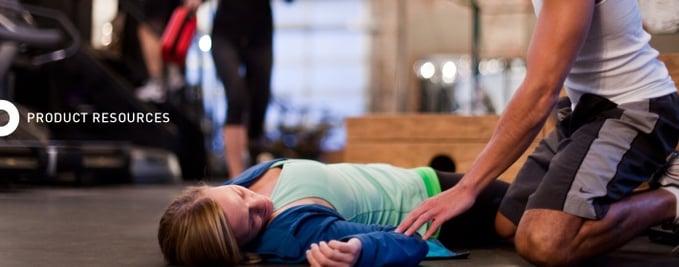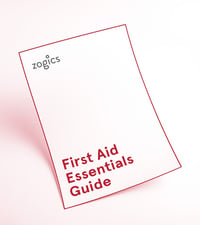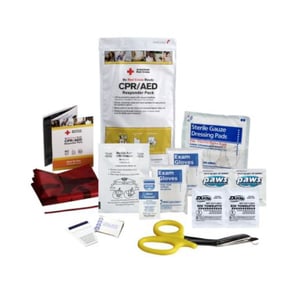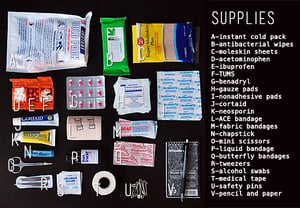First Aid Essentials

It’s National Preparedness Month! You've probably already read our post on the 7 Ways to Prepare Your Business for Emergencies. As a follow up we have created a First Aid Essentials Guide, a safety checklist and other related first aid resources to help you along the way to total preparedness.

We understand there are emergencies in this life – and often times these injuries and emergencies occur in gyms, workout settings, recreational centers, schools, universities and other high impact settings. Our resources below are designed to help you prepare now, before you need it later. But please note: while we have worked diligently to compile a robust first aid resource for you, this is not meant as a comprehensive guide for your unique first aid needs.
So, how prepared is your facility when things don’t go according to plan?
1. First Aid Essentials Guide
Download our First Aid Essentials Guide, which advises facilities on three main areas:
- Create an Emergency Action Plan. Train and drill your staff regularly.
- Maintain a well-stocked and monitored first aid kit. We provide a comprehensive list of recommended contents.
- Have an AED on-site and in working order.
Use our guide as a checklist for your staff to prepare your facility for the unexpected!
2. Choosing a First Aid Kit
 A first aid kit is one of the basic essentials any facility owner should have on the premises. It is also a must for any outdoor hiking or exploration and a must for home disaster preparedness. Always have first aid supplies on site, or with you for all of your outdoor excursions.
A first aid kit is one of the basic essentials any facility owner should have on the premises. It is also a must for any outdoor hiking or exploration and a must for home disaster preparedness. Always have first aid supplies on site, or with you for all of your outdoor excursions.
You have two basic choices when considering first aid supplies. You can either build your own kit or pick up one that has been pre-assembled. Most facility owners choose to go with a pre-assembled first aid kit as a matter of convenience. It's an easy way to make sure you have not forgotten any of the basics. Our experience indicates that it’s also a bit more economical than building a kit, piece by piece. First aid kits come in all sizes and shapes – but most kits are packed in compact, water-resistant pouches, cases or cabinets – all of which can be refilled.
Don’t know what size kit to get? Consider the following variables:
Size of facility: Most pre-assembled kits usually estimate the number of people a kit is expected to accommodate. Your results, of course, may vary.
Specific risks: Example: If you’re doing some training like Crossfit, or you manage an aquatic center or recreation facility it might be wise to carry extra bandages and ointments for a higher-than-usual total number of scrapes and body dings.
Special needs: Does anyone who visits your facility have specific medical issues? Avoid surprises and make sure your kit is equipped to address that person’s needs. A common example: Does anyone have allergies? Make sure you have the appropriate medications on hand.
3. Do-It-Yourself First Aid Kits
 Do it yourself kits should include a quick-reference guide that explains how to administer basic first aid. In addition, facility owners should make staff and managers aware of online tools and smart phone apps like the American Red Cross app (free for both iOS and Android). Other first-aid app options are listed in this 2013 Mashable roundup.
Do it yourself kits should include a quick-reference guide that explains how to administer basic first aid. In addition, facility owners should make staff and managers aware of online tools and smart phone apps like the American Red Cross app (free for both iOS and Android). Other first-aid app options are listed in this 2013 Mashable roundup.
Do it yourself kits should include - at minimum the following:
- Bandages: Assorted adhesive bandages, athletic tape and blister treatments (such as moleskin).
- Medication and ointments/lotions: Ibuprofen, antibiotic ointments, antacid tablets, sunscreen and prescription medicines.
- Basic tools: Tweezers, a small mirror, razor blade or knife.
- Miscellaneous items: Bee-sting kit, tick remover, antiseptic towelettes, burn dressing.
For larger facilities include a more comprehensive selection of items such as:
- Additional bandages: Gauze pads, ACE bandages and butterfly bandages.
- Additional drugs/lotions: Ointments for relief of skin irritations (such as Tecnu or Caladryl).
- Additional tools: Sling, basic splint, forceps, instant ice pack and thermometer.
4. First-Aid Checklist
Be prepared! All facilities should always have on hand either a prepackaged first-aid kit or a do it yourself kit. Prepackaged first aid kits typically contain many of the following items:
- Antiseptic wipes (BZK-based wipes preferred; alcohol-based OK)
- Antibacterial ointment (e.g., bacitracin)
- Compound tincture of benzoin (bandage adhesive)
- Assorted adhesive bandages (fabric preferred)
- Butterfly bandages/adhesive wound-closure strips
- Gauze pads (various sizes)
- Nonstick sterile pads
- Medical adhesive tape (10-yd. roll, min. 1" width)
- Blister treatment (e.g., Moleskin, 2nd Skin, Glacier Gel)
- Ibuprofen/other pain-relief medication
- Insect-sting relief treatment (e.g., AfterBite)
- Antihistamine to treat allergic reactions
- Splinter (fine-point) tweezers
- Safety pins
- Comprehensive first aid manual or information cards
So whether you have done all you can to protect your staff, members, and business reputation – or you’re just opening a new facility - our First Aid Essentials Guide and first aid checklists are for you.
Empower your staff and reassure your community with our FREE downloadable cleaning and disinfecting guides for fitness centers, educational settings, hospitality facilities and more.
Topics from this blog: product resource
Back



